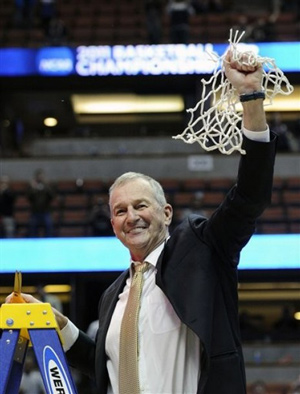Trivia time: Name the last player to average more than 22 points per game for a team that won a national championship.
Don’t bother with the last 20 years. You won’t find one. Which brings us to the intriguing case of Kemba Walker and the Connecticut Huskies.
Walker is a special player. As 6-foot scoring point guards go, there aren’t many with his range of abilities. He’s explosive, his first step enough to blow by any college defender he faces. He’s relentless, and if his stamina and ability to play on short rest hasn’t been praised enough, let it be stated here: The man never tires.
He’s played 37.6 minutes per game for a team that wouldn’t be here if that number were 36. He scores more than twice as often as any of his teammates while also leading the team in assists and steals. And he’s even the second-leading rebounder.
There are better players in the country, but it would be tough to argue for a more important one. While Walker’s shot-happy approach has been questioned at times, particularly after losses, he is the soul of the Connecticut men’s basketball team. He is the undying hope of a powerhouse program in desperate need of just this type of player at this moment.
Walker thrives in these moments.
Walker came to Connecticut in 2008 as part of a revered recruiting class including center Ater Majok, guard Nate Miles and guard Scottie Haralson. Those three players totaled 449 minutes in 43 games for the Huskies, with Miles never seeing the court and being the subject of recruiting violations that have led to the program being put on probation.
Walker stands alone. You talk about a chip on a shoulder, this young man is the lone representative from a recruiting class ranked in the top-10 nationally. A recruiting class that, thanks to the Miles controversy, has put the basketball program and coach Jim Calhoun under intense national scrutiny and subjected it to suspension, scholarship reduction and a three-game suspension for Calhoun.
In his first two seasons, the junior guard was held back. As a freshman, he played second fiddle at point to the talented A.J. Price on a team bound for the Final Four. As a sophomore, he was unable to control a team divided by selfish players (I’m looking at you, Jerome Dyson) and injuries.

This was Walker’s load to bare.
Twenty-three and nine-tenths. That’s Walker’s scoring average: 23.9 points per game. Nearly one-third of his team’s scoring. Jeremy Lamb and Shabazz Napier have shown promise, but each is a freshman. They’ll have their turn. For now, they watch Walker run the show.
He carried the team to a Maui Invitational title, beating NIT finalist Wichita State, current Final Four opponent Kentucky and then-No. 2 Michigan State by scoring 90 points over three games in three days. He dominated overtime in a stunner against Texas. He blew by Villanova, and his defender, in the final seconds of regulation against Villanova.
He won the Big East Tournament in about as singular a fashion as can be conceived.
Connecticut has several good players. It boasts just one very good player. That player is great.
But how great? National champions never rely on an individual the way Connecticut relies on Walker. Then again, the Huskies are the highest remaining seed. They dominated Kentucky in November, and now they get a chance to play the Wildcats again.
John Calipari will throw a lot of looks at Walker and Calhoun. He’s not going to be worried about the other Huskies – with the possible exception of Lamb, who should take over next year as the “man” in Storrs – and will have defensive specialist DeAndre Liggins and outstanding lead guard Brandon Knight take on Walker with major size advantages.
Kentucky’s a very good team, but Walker’s a great player. That’s something the Wildcats may not have.
Going back to that trivia question, the last player to average more than 22 points a game for a national champion was Glen Rice, the leader of the 1989 Michigan Wolverines.
That team was a No. 3 seed. That team beat the No. 2 seed in its region, but avoided the No. 1. That team was faced with a Final Four of unspectacular – if significantly higher seeded – teams.
That team had the best player in the Final Four, and maybe in the country.
Kemba Walker is that player this year. Would you bet against him?
==========
Editor’s note: Adi Joseph will be writing features on all four Final Four teams leading up to Saturday’s games. Check back later for Butler, Kentucky and VCU.
